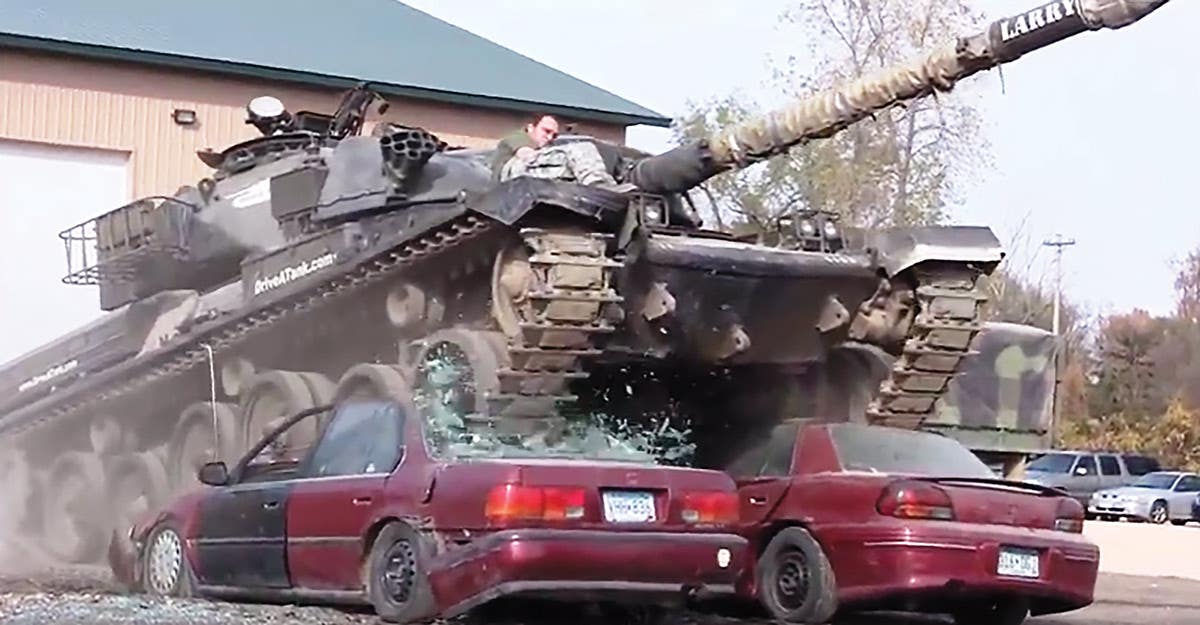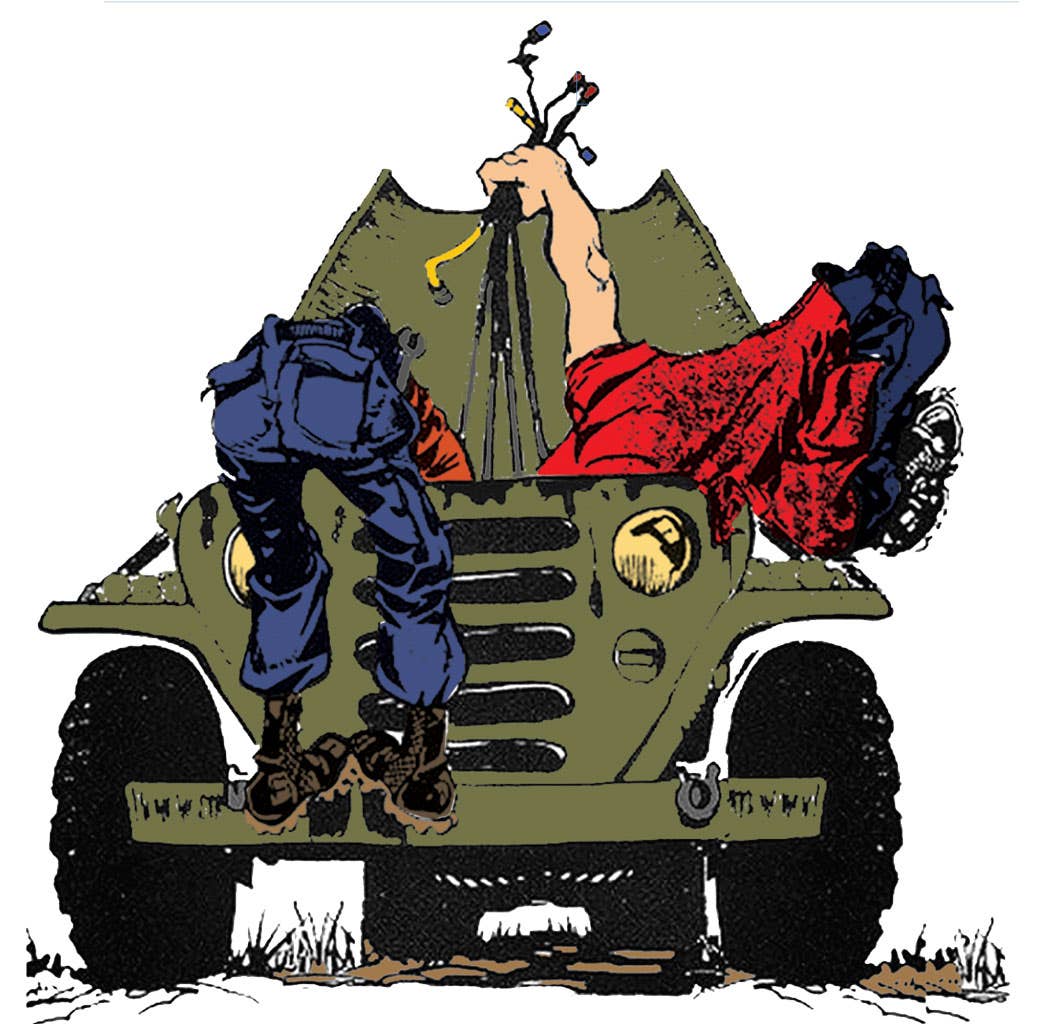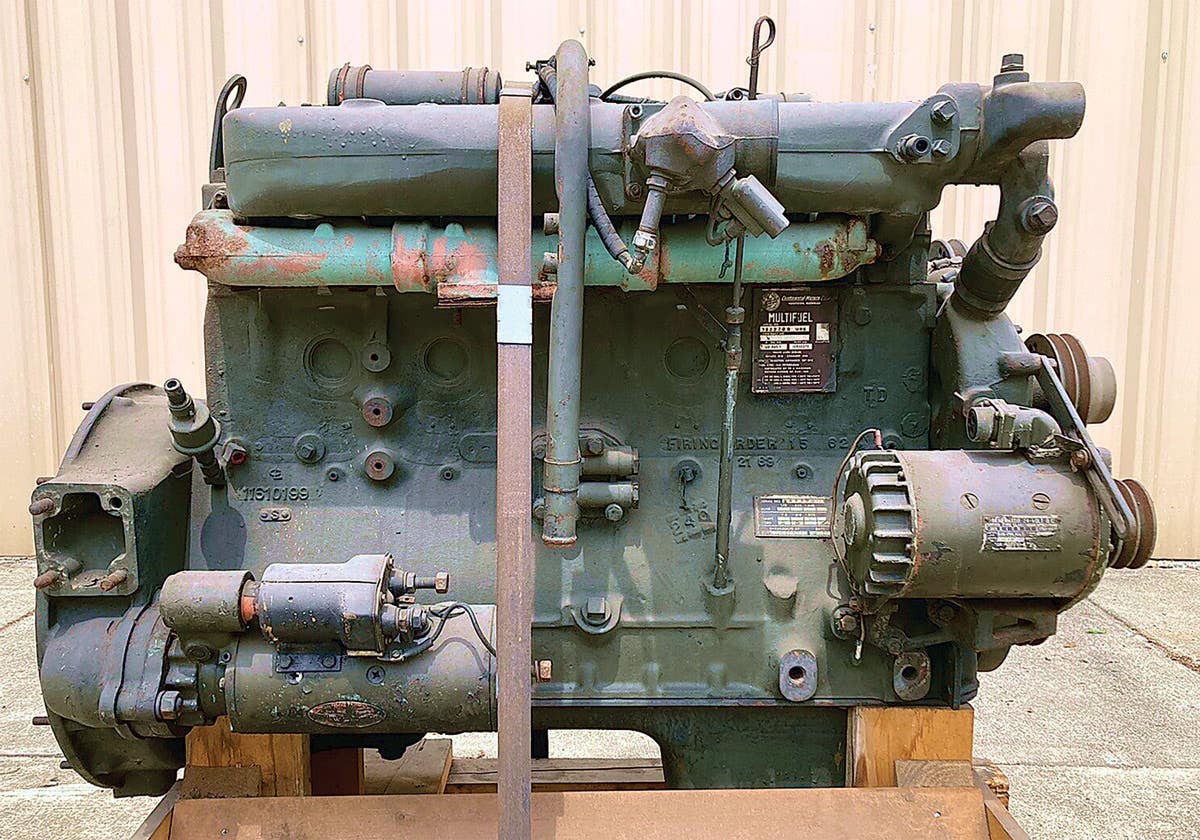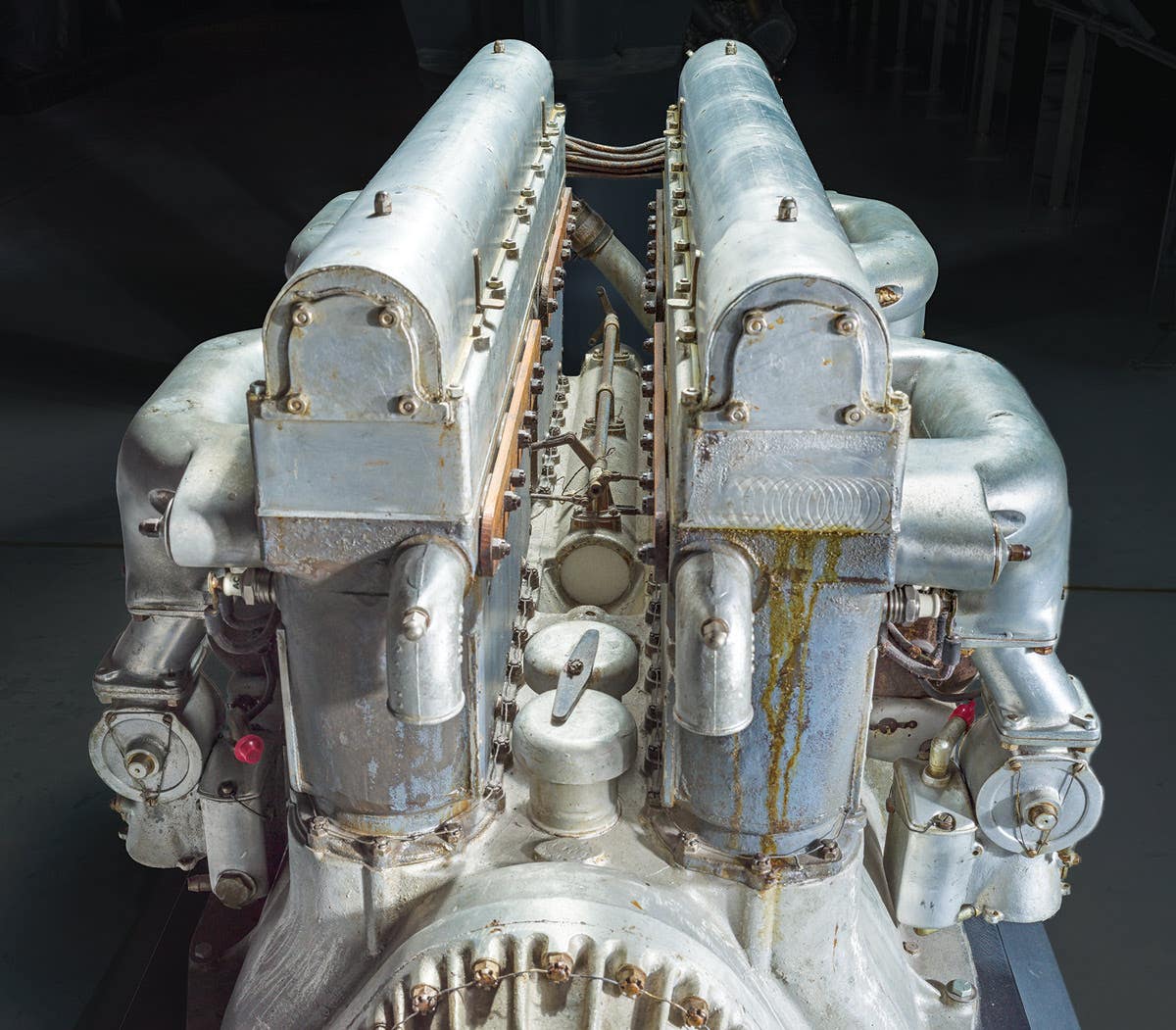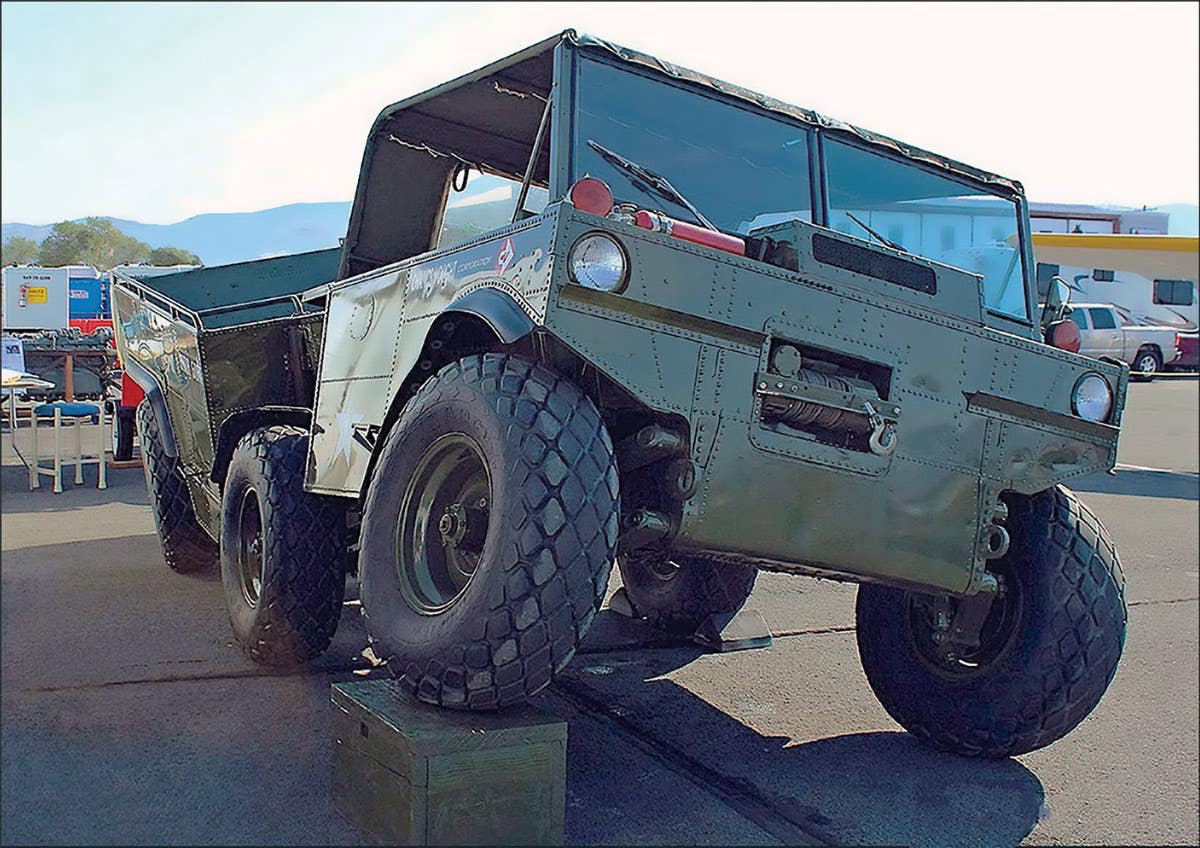A Bronco’s double life
A mysterious 1967 Ford Bronco served the military and forest service.
Paul Mayer, of Reeseville, Wis., knows first-gen Broncos. He restores them and has owned dozens of them at once, and it’s the vehicle in which he learned to drive. Yet it took him almost 20 years and a couple strangers to discover the fascinating origin of what’s likely his most interesting Bronco.
“My first vehicle I ever drove when I grew up in Cedarburg, Wis., was my dad’s [Bronco],” Mayer says. “He had a ’66 Bronco with a 170-cubic-inch six-cylinder with a manual transmission ‘three on the tree.’ It was a half-cab and had a snow plow, and I learned to drive that when I was 12 years old. I would plow parking lots and play with the truck. So that was my first ride, and I have been hooked on them ever since.
“In the ’80s I bought another Bronco, and that is when it really all started. I had a Smoker & Roaster and seasoning business and I started traveling around the U.S. and I would see Broncos lying around and would buy them up and drag them home. At one time, I had 53.”
In the midst of his corralling Broncos, Mayer changed professions and started Precision Stripping and Tires in 1993. He was completing plastic media blasting and vehicle repairs when he ran across an ad for another Bronco that was just an hour and a half away. Given its relatively close proximity, he just had to follow up on the lead.
“In 2005, the State Farmer paper came, and in it, there was a post for sale,” Mayer recalled. “It was a Bronco, a ’67 Ford Bronco, so I called and here it was at Lake Geneva, Wis., at a salvage yard, of all places. I called the guy there. His name was Bob, and I asked, ‘How solid is this thing?’ He said, ‘Very solid, it’s from out west.’ The next day, I ran down there and looked at it, and it was crap yellow, but it was a very solid Bronco, so I said, ‘I’ll take it.’ He had another one there for parts, so I bought that one, too.”
Mayer thought he was buying a 1967 Ford Bronco Sport Utility half-cab pickup like the one in which he learned to drive, but with its own interesting history. With its unusual chartreuse color and out-of-the-ordinary U.S. government data plates on the instrument panel, the Bronco appeared to have been a U.S. Forest Service pickup used for fighting fires. It took Mayer almost two decades to find out that was only half of its story, and it wasn’t a Bronco half-cab pickup at all.
Breeding the Bronco
When Ford Motor Co. debut the compact Bronco SUV for 1966, it became the first of the Big Three automakers to take on the four-wheel-drive utility vehicle market dominated by the Willys Jeep and the International Scout. Planning for Ford’s new SUV began in the early 1960s, and by early 1964 $10 million had been planned on the project. Ford expected Bronco buyers would be World War II veterans who fondly remembered the jeep, but were at a point in life where they wanted more comfort. They expected additional Bronco buyers would be active outdoorsmen and young, college-age people who needed space for play over people. Ford suggested the Bronco would also be of use to the service industry as a light work truck.
To keep costs down, the Bronco was developed using parts from existing Ford models, whether car or truck. Use of existing engines was planned, and some of the Bronco’s trim parts, lenses and gauges were from other Ford products. Not only did the Mustang loan its seats to the Bronco, its successful horse theme inspired the Bronco name used on the diminutive, 92-inch-wheelbase SUV. The big F-100 Ford pickup loaned its bed sides to the design of the Bronco’s quarter panels, which had the added benefit of keeping a family resemblance to the new truck model.
When Ford introduced the new 1966 Bronco on Aug. 11, 1965, it offered three models: the topless U13 Roadster, the U14 Sports Utility with a truck bed (aka half-cab pickup) and U15 Wagon with a fully enclosed, continuous roof from the windshield to the tailgate. By using the same body tub for each of these three models, Ford reduced its manufacturing costs, but it also made it relatively easy for owners to switch the body type from one model to the next.
Buyers also enjoyed the Bronco’s comfort, stability and maneuverability that engineers had improved over the Willys Jeep and International Scout that the Bronco had been engineered against. With its four-wheel drive and short wheelbase, the first-generation Bronco made an especially apt snowplow vehicle, and even today, Broncos from the 1960s and ’70s can occasionally still be seen moving snow.
For all of its utility and newness, the Bronco sold about 24,000 units in 1966, which was more than half of the combined total of 40,000 or so compact SUVs sold in the United States during 1965. These competitors not only included the International Scout and Willys Jeep, which made up most of the U.S. SUV sales, but also the Nissan Patrol and Toyota Landcruiser, which combined made up about 6,000 sales in the United States.
The U15 Wagon was far and away the most popular Bronco type despite being the most expensive version at a $2,625 base price. In the Bronco’s introductory year, 12,756 U15 Wagons were built. The second-most-popular Bronco was the U14 Sport Utility pickup, of which 6,930 were built for 1966, followed by the U13 Roadster, the cheapest Bronco at a $2,404 base price, and that saw sales of 4,090 units. Sales of the U13 Roadster would never again approach that figure. Just 698 were built in 1967, and only 212 were built in 1968, leading the U13 Roadster to be dropped for 1969.
Ford had expected the Bronco to appeal to those buyers who wanted more comfort than the Jeep and Scout offered, and low sales of the Spartan U13 Roadster proved Ford was right. The U13 Roadster was such an extremely basic vehicle that it lacked a provision for a top or even doors! However, a collapsible aftermarket Whitco top was available from Ford dealers, as were doors, but both came at extra expense for U13 Roadster buyers. Without either, a Bronco U13 Roadster was only fitting for warm and sunny days when there was little risk of rain or frigid wind chills, which surely limited the open roadster truck’s appeal. Lacking top and side protection from the elements, the Bronco U13 Roadsters were even more susceptible to rust than the fully enclosed U14 Sport Utility and U15 Wagon, making the already rare U13 Roadster extremely scarce today. However, the lack of features that made the U13 Roadster rare and more at risk of decay has made them the most desirable Bronco model today. As a result, some U14 Sport Utility and U15 Wagon owners have converted their Broncos into roadsters by removing the doors and roofs and installing the Roadster’s bolt-on door inserts to gain its sporty flair. Once such a conversion has been done, it becomes necessary to look at a Bronco’s VIN for the U13, U14 or U15 prefix to determine how that Bronco was built originally.
A moment of discovery
Given that his newly purchased Bronco had been modified as a fire-fighting vehicle by the U.S. Forest Service, Mayer knew he wasn’t looking at a bone-stock Bronco. The truck appeared to be original to its forestry days, so he never considered the need to check its VIN and verify that it was anything but the U14 Sport Utility that it appeared to be.
“I never looked real close at it and I never thought it was a roadster,” Mayer says. “I saw the (government) tag that it was a forestry Bronco, and that’s what (the seller) told me. I bought it and I drove it around for a while, and I had no idea that it was a U13.”
After driving the Bronco as-purchased for a few summers in the early 2000s, Mayer parked it in a semi trailer to work on other Broncos. Given its solid body and unique forest service background, he planned to restore it back to its chartreuse days when it fought spot fires.
“I was going to [sand] blast it and return it to a forestry truck, but I am really glad I didn’t do it.”
Before he could strip down the truck to restore it to its forest service days, fate intervened. There was a Bronco meet coming up and Mayer hadn’t finished the Bronco he planned to drive, so out of its stable came the “crap yellow” 1967 Bronco.
“In 2023, I was working on my son’s Bronco and wanted to take it to a Bronco Driver Super Celebration in the Wisconsin Dells, but I didn’t get it done,” Mayer recalls. “I had paid $90 to get a Bronco in there, and all I had was this yellow one. I just got to changing the fluids, put a battery in it and I fired it up. Then I loaded it on a goose neck trailer and took it there. That’s when I found out what it was.”
At the Bronco meet, Mayer said model experts Tim Hulick and Andy Stone approached his vehicle and, after inspecting it, they asked him a question that would change his direction on the Bronco’s future.
“They said, ‘Do you know that you have? It’s a military Bronco Roadster.’ I had no clue.
“I had looked right past the VIN on it and never gave it any thought it could be a Roadster. I always thought, ‘Gee, someday I would like to find a Roadster,’ and here I got one!”
Researching a well-traveled Ford
The realization that his Bronco wasn’t a U14 Sport Utility, and that it had been a military vehicle as well as a Forest Service vehicle, set Mayer on a path of research. When he bought the Bronco, Bob, the seller, gave Mayer enough details of his purchase from a fire department that Mayer was able to trace the Bronco back to when it had been stationed with the U.S. Forest Service.
“Bob went out elk hunting in 2004, and went to a different area where he never hunted before. He went to this little town of New Castle, Wy., and they came into town and here, across the street, was this Bronco with a ‘for sale’ sign. So, he looked at it and here it’s a sealed bid auction. He writes down the info and puts in a sealed bid and they contacted him later that winter and said, ‘You have the bid.’ I have a copy of that paperwork.”
Using the sale paperwork from the fire department that auctioned the Bronco, Mayer reached out to the U.S. Forest Service station where the Bronco had served and told them of his purchase. The person he spoke to wasn’t familiar with the truck, but gave Mayer’s phone number to a retired employee who would have been working there when the Bronco was in use.
“One day, out of the blue, about a year after, I received a call from a 715 number in Rhinelander, Wis., and the gentleman’s name was Steve Macheichok,” Mayer said. “He informed me that he was the retired fire chief out there in New Castle, Wy., and that he knew all about this Bronco and another one while he was there. They were both under his commission, so he started telling me the history of it.
“It came out of Fort Hill, a place in Utah where they gather used military equipment after its use. It is then put into a military pool to be re-purposed for civil and public use, or to be scrapped, depending on its condition.”
Macheichok told Mayer that the U.S. Forestry Service had acquired two military Broncos (Mayer’s U13 Roadster and a U14 Sport Utility). They both were sent to the New Castle Fire Department to become first responder units to be placed on ranches around the county. The U13 Roadster was fitted with a bulk head, a half-cab metal roof and a water tank with a gas-powered pump that was installed in the box, along with other fire fighting equipment. It was painted safety yellow and had a large number 71 painted on the hood, as the fire department had more than 100 units for fighting spot fires. Unit 71 was sent to serve Senator Tysdal’s ranch where it was stored in a shed to protect it from the elements.
Unfortunately for the other Bronco, it went to another ranch where it sat outside and rusted away, and then was scrapped. When the fire department was done with its service of Unit 71, the U13 Roadster Bronco, it was then put up for public auction.
Mayer could now verify its U.S. Forest Service and military use, and how it came to look like a U14 Sport Utility. A few other clues on the truck told him which branch of the military it had served.
“There is Air Force Blue underneath the yellow,” Mayer says. “When I pulled out the cardboard glove box to get the heater core out, a 1973 tag from the Air Force fell out.”
Modifying a Bronco
Little is known about the Ford Broncos ordered by the U.S. government, and those few who are familiar with them are more a part of the Bronco community than the MV community.
Dustin and Anne Olson recorded what they have learned about military Broncos in Issue #51 of Bronco Driver Magazine. Their research showed as many as 120 Broncos had been ordered by the U.S. government in early 1967 to be split among the four military branches. The 120 Broncos appear to have been a mix of U13 Roadster, U14 Sport Utility and U15 Wagon models, but no breakdown is available. However, the Marti Auto Works Report for Mayer’s U13 Roadster states that all of the U13 Roadster Broncos ordered by the government were identically equipped, and there were 54 U13 Roadsters with the 170-cid six-cylinder engine, three-speed manual transmission, Special Paint, glassed and framed doors, Parchment Rosette bucket seats, rear seats and a cigar lighter, but no radio. The truck was part of a government fleet order with Ford Dealer No. 830000 associated with “District of Columbia Government, 300 Indiana Ave NW, Washington, DC 20001.” The order for Mayer’s Bronco (and presumably the rest of them) was received on Jan. 10, 1967, and it was actually built on April 3. It was released from Ford Motor Co. on April 14. Interestingly, the Marti Report for a 1967 Bronco Wagon ordered by the military shows the same January date for the order, but a build date of May 22, so all military Broncos weren’t built at the same time.
It’s not clear whether the half-ton Broncos were being considered as replacements for the quarter-ton jeep, or were simply meant to complement the jeeps in military pools.
Bronco U13 Roadsters destined for military service were additionally equipped with 850-lb. front springs, 7.35x15 four-ply rated black sidewall tires with mud and snow tread, skid plates, cigar lighter, exhaust emission controls, closed crankcase emission system, heavy-duty 55-amp battery and rear reflectors. Notably, at least some of these U13 Roadsters also had doors with windows fitted, rather than the open door passages of civilian U13 Roadsters. (Dealers are also said to have sometimes fitted doors to move slow-selling U13 Roadsters off their lots.)
Military Broncos were ordered from Ford with “special paint.” The Olson’s research shows the military Broncos were sent to the respective branch of service in which they would be used and painted the appropriate color there (olive drab for U.S. Army, gray for U.S. Navy, dark blue for U.S. Air Force and green for the U.S. Marine Corps). Military personnel further modified them for duty.
“The rear bumper is a C channel, that was government, and they put on a pintle hitch — some had a trailer plug in them, but mine doesn’t have that,” Mayer said. “The front bumper would have been stock, and then I am pretty sure the forestry department put the hooks on there for a tow bar, but it could have been the Air Force.”
In addition, each Bronco would have been stenciled on the sides, front and back, with its registration number and the branch of service. Additional codes were painted with stencils under the hood to direct maintenance procedures. Existing period photos of military Broncos also show them with guards installed over the headlamps.
Once Mayer’s Bronco finished serving in the U.S. Air Force near Tooele, Utah — probably Hill Air Force Base (that is where the history trail ended, as no government records are available) — it was sent to the U.S. Forest Service in New Castle, which further modified it.
“There are some numbers on the left side of the front bumper for the forestry department,” Mayer said. “There is a metal data plate for the forestry department mounted on the dash, next to the glove box, and another metal [military data plate] mounted on the glove box door. The ‘71’ on the hood would be for the fire department, so it could be identified by air. There are holes on the driver’s side, by the gas tank, that I was told were probably for mounting a 5-gallon jerry can.”
In addition, Mayer’s Bronco was fitted by the Forest Service with a rollbar, which it retains. It also installed a water tank and pump on the back, and although now long gone, there are still signs they were there.
“They put a 2-inch-square, heavy tubing and longer U bolts on the springs to level it out from the weight of the water tank. That is one thing I noticed,” he said. “Mine also had a PTO, but it was never run into the cab, but it has it on the transfer case. The PTO is not on the Marti Report.”
Each door of Mayer’s Bronco also had a U.S. Forest Service decal, but they were badly faded on Mayer’s truck and had to be recreated. With some help, Mayer made new ones as magnets that he could mount over the original decals without disturbing them.
“A lady from the forestry department sent me pictures of a Dodge out in the junk yard with the decal still on it, so that’s how I got those decals matched up,” Mayer said.
Restore or preserve
With the Ford having led two important lives before retiring to the life of a collector vehicle, Mayer found himself in a quandary. Restore it to its original U.S. Air Force configuration, or to its U.S. Forest Service configuration? Or, does he return it to the open-doorway U13 Roadster he always dreamed of owning?
“When I started trying to find out what the U.S. Forest Service decals looked like and what was all on it, that’s when I decided what direction to go with it,” Mayer said. “After I had started researching that, I talked to Tim Hulick, and since it tells two stories, I decided to keep it that way.”
So, rather than pick one direction, Mayer has decided to preserve the vehicle as it is with signs from both lives. By removing paint to restore it one way or the other, he’d be erasing at least one of its pasts. Although he’s chosen to preserve the Bronco, he’s not sitting idle. Mayer has figuratively and literally been filling the holes of its past through research and by reinstalling missing parts where holes were drilled in the body for military or forest service equipment.
Among the holes Mayer has already filled are those for the military-spec headlamp guards. When he purchased his Bronco, the guards were missing, but Hulick was able to supply reproductions. He found an owner’s manual for a CB radio in the glove box and corresponding holes in the instrument panel for a CB radio from the Bronco’s forest service days, so Mayer reinstalled a period-correct unit.
The rear seats are missing from the back of his Bronco, probably replaced by the water tank and pump when the truck went into a fire-fighting role, so he’d like to find pictures of what they should look like.
“I was told that some military Broncos had seats that folded up and were mounted on the rear inner fender wells, similar to that of a Jeep,” he noted. Empty holes on the rear fenders of his Bronco, and metal snap mounts on the windshield frame, lead Mayer to suspect his Bronco once had a canvas top, too, perhaps constructed by military personnel.
Although he’s working hard to keep evidence of the truck’s past lives visible, there are some things that Mayer is returning to the Bronco’s earliest, pre-military life. “There were some things that were painted in the engine compartment that were red — they just painted it red with a spray can — but it deserved Ford blue,” he added. “The air cleaner is supposed to be black and it has to go back to that color. So, I have just been dressing up the engine compartment.”
However, in his efforts, Mayer has been careful not to mask over the many military and Forest Service stencils under the hood.
Mayer’s biggest problem is that he’s always wanted to experience the open-air feeling of a Bronco U13 Roadster model, and even though he technically has a Roadster, he still doesn’t exactly have one.
“Yeah, I’d still like to get a roadster!”
If you are able to share any knowledge of Ford Broncos used in the military or U.S. Forest Service, please write to Military Trader & Vehicles at military@aimmedia.com or PO Box 658, Neenah, WI 54957.
Angelo Van Bogart has been an editor at Old Cars since 2001. In addition to working as the current editor of Old Cars, he has authored the books "Cadillac: 100 Years of Innovation," "Hot Wheels: 40 Years" and "Hot Wheels Classics: The Redline Era" among others. He also serves as a judge at numerous international club and concours events.



